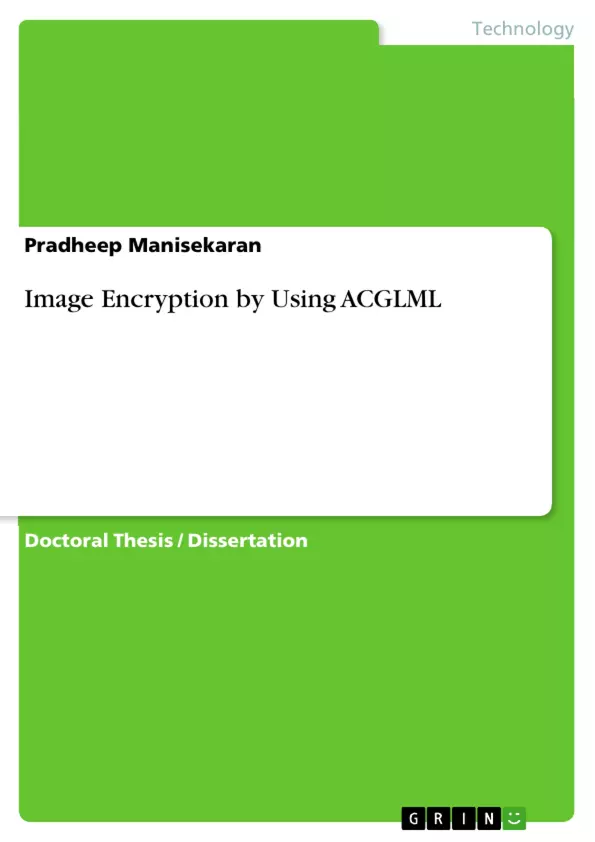In the present-day era of typical social media communications, it is vital that privacy is to be preserved due to attacks on multimedia data through various methods. It is well known that the encryption standards either lack in keyspace or poor encryption strength. Hence, it is proposed to use a novel method in which both keyspace and encryption are increased.
Discrete cosine transforms (DCT) of the image are encrypted using a generalized logistic equation. Due to this idea, both compression and encryption are done simultaneously. Before applying DCT, the image is shuffled using Arnold Cat Map. The proposed compression and encryption method is validated using several chaotic metrics such as; Bifurcation diagram, Mutual information, Kolmogorov Sinai Entropy density, Kolmogorov Sinai Entropy generality, Space-Amplitude diagram, Space-Time diagram. Intruders are discouraged through the improved metrics such as NPCR (Number of Pixels changing rate), UACI (Unified Averaged changed intensity), and mutual information among the lattices used as the key.
In the same way, image reconstruction quality is improved and verified through the metrics such as PSNR (Peak Signal to noise ratio) and FOM (Figure of Merit). Compression performance is evaluated through the metric CR (Compression ratio). The performance is evaluated for both gray and color image databases under a noisy channel environment.
Inhaltsverzeichnis (Table of Contents)
- CHAPTER 1: INTRODUCTION
- 1.1 Motivation
- 1.2 Encryption Basics
- 1.2.1 Terminologies in Image Encryption
- 1.2.2 Terminologies in Cryptography
- 1.3 Image Compression Basics
- 1.4 Challenges to Meet
- 1.5 Thesis Organization
- CHAPTER 2: LITERATURE REVIEW
- 2.1 Introduction
- 2.2 Non-Chaotic Based Encryption
- 2.3 Chaotic Based Encryption
- 2.3.1 Full Encryption
- 2.3.1.1 Spatial Domain
- 2.3.1.2 Frequency Domain
- 2.3.1.3 Hybrid Domain
- 2.3.2 Selective Encryption
- 2.3.2.1 Spatial Domain
- 2.3.2.2 Frequency Domain
- 2.3.2.3 Hybrid Domain
- 2.3.1 Full Encryption
- 2.4 Compression Methods
- 2.4.1 Lossy Compression Methods
- 2.4.1.1 JPEG - Joint Picture Expert Group
- 2.4.1.2 JPEG 2000
- 2.4.2 Lossless Compression Methods
- 2.4.1 Lossy Compression Methods
- 2.5 Summary
- CHAPTER 3: CHAOS THEORY IN ENCRYPTION
- 3.1 Summary
- CHAPTER 4: MATERIALS AND METHODS
- 4.1 Introduction
- 4.2 Chaotic Metrics
- 4.2.1 Mutual Information
- 4.2.2 Kolmogorov-Sinai Entropy (Density And Generality)
- 4.2.3 Bifurcation Diagram
- 4.2.4 Standard Deviation of Lattice Value
- 4.3 Image Quality Metrics
- 4.4 Proposed Encryption
- 4.5 Compression Scheme
- 4.5.1 Discrete Wavelet Transforms
- 4.5.2 Wavelet Filter Banks
- 4.5.3 Properties of Wavelets
- 4.6 Summary
- CHAPTER 5: RESULTS AND DISCUSSIONS
- 5.1 Mutual Information
- 5.2 KSE Density and Generality
- 5.3 Bifurcation Diagram
- 5.4 Space-Time Diagram
- 5.5 Space-Amplitude Diagram
- 5.6 Encryption Performance (Gray)
- 5.7 Key Sensitivity Analysis (Gray)
- 5.7.1 UACI and NPCR
- 5.7.2 Correlation Co-Efficient
- 5.8 Encryption Performance (Color)
- 5.9 Key Sensitivity Analysis (Color)
- 5.9.1 UACI and NPCR
- 5.9.2 Correlation Co-Efficient
- 5.10 Summary
Zielsetzung und Themenschwerpunkte (Objectives and Key Themes)
This thesis explores the use of chaotic maps for image encryption and compression. The main objective is to develop a robust and efficient image encryption and compression scheme based on chaotic dynamics.
- Chaotic Encryption and Compression
- Image Security and Privacy
- Wavelet Transform Techniques
- Performance Evaluation and Analysis
- Applications of Chaotic Systems in Image Processing
Zusammenfassung der Kapitel (Chapter Summaries)
- Chapter 1: Introduction - This chapter provides an overview of the motivation behind this research, a review of essential encryption and compression basics, and a summary of the challenges addressed in the study.
- Chapter 2: Literature Review - This chapter presents a comprehensive review of existing encryption and compression techniques, highlighting both chaotic and non-chaotic approaches. The chapter explores various spatial and frequency domain methods as well as hybrid approaches.
- Chapter 3: Chaos Theory in Encryption - This chapter delves into the role of chaos theory in image encryption, showcasing the use of chaotic maps for permutation and diffusion processes.
- Chapter 4: Materials and Methods - This chapter outlines the research methodology, including the chaotic metrics used for performance evaluation, the proposed encryption and compression scheme, and the implementation of wavelet transforms.
- Chapter 5: Results and Discussions - This chapter presents the results of the proposed encryption and compression scheme, including analyses of mutual information, KSE density, bifurcation diagrams, space-time diagrams, space-amplitude diagrams, and encryption performance in both grayscale and color images. The chapter also discusses key sensitivity analysis using metrics such as UACI, NPCR, and correlation coefficients.
Schlüsselwörter (Keywords)
Image encryption, chaotic maps, wavelet transforms, compression, security, privacy, performance evaluation, image processing, UACI, NPCR, correlation coefficients.
- Quote paper
- Dr. Pradheep Manisekaran (Author), 2021, Image Encryption by Using ACGLML, Munich, GRIN Verlag, https://www.grin.com/document/1022972



